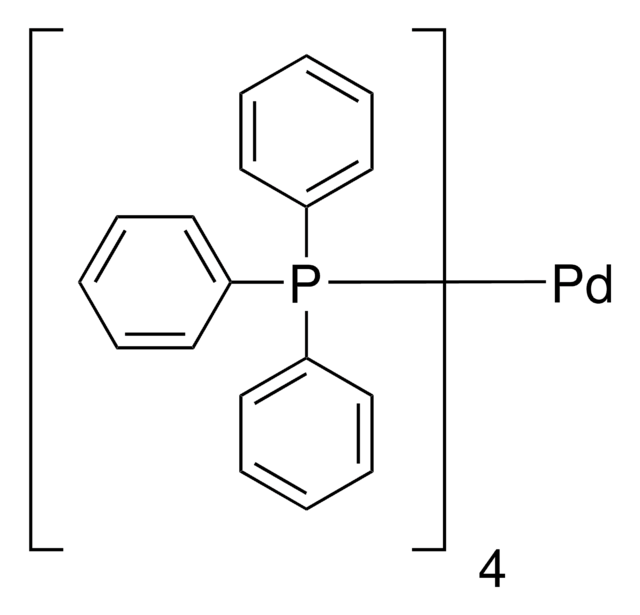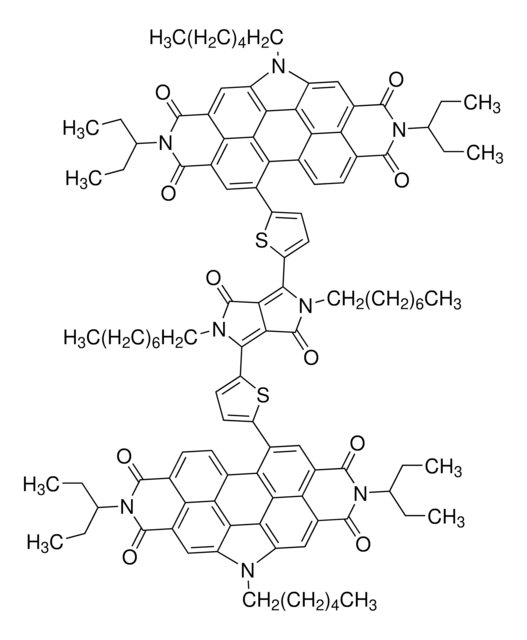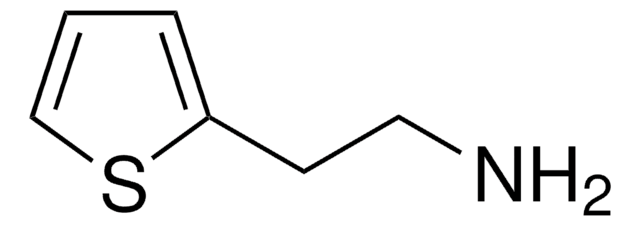767743
2,5-Dihydro-3,6-di-2-thienyl-pyrrolo[3,4-c]pyrrole-1,4-dione
97%
Synonym(s):
3,6-Di(thiophen-2-yl)pyrrolo[3,4-c]pyrrole-1,4(2H,5H)-dione, DPP
Sign Into View Organizational & Contract Pricing
All Photos(1)
About This Item
Empirical Formula (Hill Notation):
C14H8N2O2S2
CAS Number:
Molecular Weight:
300.36
MDL number:
UNSPSC Code:
12352103
PubChem Substance ID:
NACRES:
NA.23
Recommended Products
Quality Level
Assay
97%
form
solid
SMILES string
O=C1NC(c2cccs2)=C3C(=O)NC(c4cccs4)=C13
InChI
1S/C14H8N2O2S2/c17-13-9-10(12(16-13)8-4-2-6-20-8)14(18)15-11(9)7-3-1-5-19-7/h1-6H,(H,15,18)(H,16,17)
InChI key
YIUHGBNJJRTMIE-UHFFFAOYSA-N
Related Categories
General description
2,5-Dihydro-3,6-di-2-thienyl-pyrrolo[3,4-c]pyrrole-1,4-dione is a diketopyrrolopyrrole (DPP) based copolymer and are used widely in thin-film transistors and solar cell devices. This aromatic polymer has electron withdrawing groups and hence is very useful for the synthesis of narrow band gap donor-acceptor polymers which are used as active semiconductors for organic electronics. They give rise to high power conversion efficiency (PCE) in Organic Photovoltaic (OPV) Cells.
Application
Used in the synthesis of donor-acceptor polymers which are used in polymer field-effect transistors and bulk heterojunction solar cells.
Features and Benefits
Diketopyrrolopyrrole is planar and can accept hydrogen bonds/other electrostatic interactions which results in copolymers that have pi-pi stacking.
Signal Word
Warning
Hazard Statements
Precautionary Statements
Hazard Classifications
Acute Tox. 4 Oral - Eye Irrit. 2 - Skin Irrit. 2 - STOT SE 3
Target Organs
Respiratory system
Storage Class Code
11 - Combustible Solids
WGK
WGK 3
Flash Point(F)
Not applicable
Flash Point(C)
Not applicable
Regulatory Information
新产品
Choose from one of the most recent versions:
Already Own This Product?
Find documentation for the products that you have recently purchased in the Document Library.
Influence of Side-Chain on Structural Order and Photophysical Properties in Thiophene Based Diketopyrrolopyrroles: A Systematic Study.
Naik, M. A., Venkatramaiah, N., Kanimozhi, C., & Patil, S.
The Journal of Physical Chemistry C, 116(50), 26128-26137 (2012)
David Rais et al.
ChemPlusChem, 85(12), 2689-2703 (2020-12-18)
The singlet fission (SF) process discovered in bis(thienyl)diketopyrrolopyrroles (TDPPs) can boost their potential for photovoltaics (PV). The crystal structures of TDPP analogs carrying n-hexyl, n-butyl, or 2-(adamant-1-yl)ethyl substituents are similar, but contain increasingly slipped stacked neighbor molecules. The observed SF
Synthesis and characterization of phenanthrocarbazole-diketopyrrolopyrrole copolymer for high-performance field-effect transistors
Chen, H., Guo, Y., Sun, X., Gao, D., Liu, Y., & Yu, G.
Journal of Polymer Science Part A: Polymer Chemistry, 51(10), 2208-2215 (2013)
Hugo Bronstein et al.
Journal of the American Chemical Society, 133(10), 3272-3275 (2011-02-22)
We report the synthesis and polymerization of a novel thieno[3,2-b]thiophene-diketopyrrolopyrrole-based monomer. Copolymerization with thiophene afforded a polymer with a maximum hole mobility of 1.95 cm(2) V(-1) s(-1), which is the highest mobility from a polymer-based OFET reported to date. Bulk-heterojunction
Our team of scientists has experience in all areas of research including Life Science, Material Science, Chemical Synthesis, Chromatography, Analytical and many others.
Contact Technical Service![Benzo[1,2-b:4,5-b′]dithiophene-4,8-dione 97%](/deepweb/assets/sigmaaldrich/product/structures/418/544/b7faac0b-ad09-4b42-a9fa-aeb38017a39e/640/b7faac0b-ad09-4b42-a9fa-aeb38017a39e.png)
![3,6-Bis(5-bromo-2-thienyl)-2,5-bis(2-hexyldecyl)-2,5-dihydro-pyrrolo[3,4-c]pyrrole-1,4-dione 98%](/deepweb/assets/sigmaaldrich/product/structures/128/499/590a62c1-529b-42e2-96df-25659ec8c9e0/640/590a62c1-529b-42e2-96df-25659ec8c9e0.png)

![1,1′-[4,8-Bis[5-(2-ethylhexyl)-2-thienyl]benzo[1,2-b:4,5-b′]dithiophene-2,6-diyl]bis[1,1,1-trimethylstannane]](/deepweb/assets/sigmaaldrich/product/structures/611/912/a638a6fe-ca7b-4674-8023-df4c0921a9fd/640/a638a6fe-ca7b-4674-8023-df4c0921a9fd.png)
![Dithieno[3,2-b:2′,3′-d]thiophene 97% (HPLC)](/deepweb/assets/sigmaaldrich/product/structures/502/826/9222eb9f-669e-4f11-ad3a-91a3d43058cd/640/9222eb9f-669e-4f11-ad3a-91a3d43058cd.png)
![Thieno[3,2-b]thiophene 95%](/deepweb/assets/sigmaaldrich/product/structures/353/609/429fd4bf-e217-4371-80a3-9e5a4d88908b/640/429fd4bf-e217-4371-80a3-9e5a4d88908b.png)
![4,7-Dibromobenzo[c]-1,2,5-thiadiazole 95%](/deepweb/assets/sigmaaldrich/product/structures/711/964/3fd3ffd1-5916-468e-a743-22f1611b5a33/640/3fd3ffd1-5916-468e-a743-22f1611b5a33.png)



